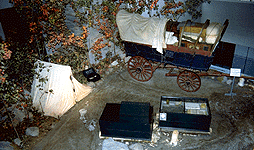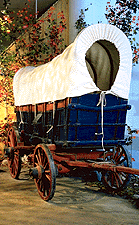Canada Hall
 Arriving in Upper
Canada
Arriving in Upper
Canada
Following the American Revolutionary War of 1775 to 1783, waves of immigrants, who came to be known as Loyalists, poured into Canada. They were a highly diverse group, both in terms of their ethnic background and their socioeconomic status. The majority were farmers, artisans, soldiers, labourers, and craftsmen, who were accompanied by their families. Besides those of British and European descent, there were blacks and Native people from the six Iroquois nations. Led by Joseph Brant, the Iroquois were granted land on the Grand River in southern Ontario as compensation for lands lost in New York State.
For many Loyalists, leaving home was a matter of survival. Anyone sympathetic to the British cause could have their land confiscated, be stripped of their civil rights, or be subjected to violence, mob persecution, even imprisonment. Other groups, such as Quakers and Pennsylvania Germans decided to emigrate to avoid religious persecution. They were disliked in the United States because their belief in pacifism obliged them to remain neutral during the war. Many of these religious communities relocated in Waterloo County, Upper Canada, where their descendants can be found today. The Pennsylvania Germans were also attracted to Upper Canada because of the availability of inexpensive tracts of farmland. From about 1800 to l830, these people seized the opportunity to begin a new life, as their forebears had done when they left Europe for Pennsylvania in the seventeenth century.

Loyalist refugees who were relocated in what is now Ontario and Quebec in 1784 were housed in tents the first few months. Inside the tent on display, a woman has just given birth, assisted by a midwife. The relocation was organized by the British government. As land grants were issued, homes were built and farms established.
 The Conestoga
wagon, named after the Conestoga Valley in Pennsylvania,
was developed by Pennsylvania Germans for long-distance travel and to
transport goods to and from market. This sturdy wagon could withstand
rough terrain and cross streams. Depending on the number of horses used,
it could haul a load weighing up to eight tons, making it an ideal vehicle
for the five-week journey from Pennsylvania to Waterloo County in Upper
Canada.
The Conestoga
wagon, named after the Conestoga Valley in Pennsylvania,
was developed by Pennsylvania Germans for long-distance travel and to
transport goods to and from market. This sturdy wagon could withstand
rough terrain and cross streams. Depending on the number of horses used,
it could haul a load weighing up to eight tons, making it an ideal vehicle
for the five-week journey from Pennsylvania to Waterloo County in Upper
Canada.
Inside the wagon could be found items needed to re-establish a farm, including: sacks of seeds, namely wheat and flax, for the first planting season; tools such as rakes, hoes, ploughs, and scythes for tending the fields; food needed for the journey and for the period before the first crops could be harvested; livestock, namely sheep and cattle; and tools and hardware for building barns and houses. In short, limited space meant that only the most essential items were brought on the journey, along with highly valued personal and religious possessions. Most items were stored in trunks, while tools were attached to the outside of the wagon.

